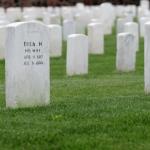"Memorializing Women: Interview with Dr. Bryce Carpenter," Interview, 2018, RRCHNM.
Over time women were memorialized in several ways. Probably the most commonly observable kind is women who have been spouses of veterans and servicemembers who have been interred. You can tell the spouse because they’re on the back of a gravestone, a gravesite marker or headstone. Sometimes the spouse passes first and then their name will be on the front but then when the veteran passes they make a new stone and the spouse’s name is recut onto the back of the stone. Women who served in uniform are also memorialized in national cemeteries too and that’s of particular interest to a great deal of professional amateur scholars. Women have served in every conflict, in uniform, whether or not they’ve been in the chain of command. For example during the Civil War period there were Army nurses, but they didn’t hold the rank.
That said, we do have, interred in San Francisco National Cemetery, the first female commissioned officer of the United States Army: Major Pauline Cushman Fryer who was a Union Army spy. We don’t really see more women who’ve served in uniform and have had a rank until we get to later periods, particularly WWII but we do see a lot of women who served in WWI and then, of course, in WWII in variety, in capacities where at that point they are holding the same rank and participate in all levels of the chain of command as their male counterparts. Women who’ve served, women veterans, account for, depending on the particular cemetery, anywhere from one to three percent of overall burials, but that number is increasing overtime as the percentage of women who serve in uniform increases overtime as well.
The one interesting shift in perceptions: we’ve had a lot of people always refer to the “wife” on the back of the stone as opposed to the “spouse”, but we’re now seeing the other way around where the female member of a couple is the veteran and the male is the spouse on the back. Of course as the definition of marriage changes from state to state, we’re seeing all kinds of couples with veterans being interred with their spouse. Those are probably the interesting changes to see how women have been memorialized.
Remembering Women Who Serve
Women continued to break new ground in the U.S. military after World War II. Dolores Stover (buried in Alexandria National Cemetery) enlisted in the United States Marine Corps in 1945 along with over 350,000 other women who served in non-combat roles. An unprecedented 40,000 women served in the 1991 Gulf War and engaged with enemy forces. Cynthia Aidoock (also buried in Alexandria National Cemetery) served as an intelligence analyst and was deployed twice to Iraq and once to Afghanistan. As of 2015, women make up about 15% of the U.S. military. More than 165,000 women are enlisted and active in the armed services with over 35,000 additional women serving as officers. On December 3, 2015, the Pentagon announced that all combat jobs would be open to women. In a press conference, Defense Secretary Ashton Carter said that "there will be no exceptions" to the new rule, though the U.S. military has been slow to integrate women into formal combat roles. In addition to access to greater roles in the military, since World War II female veterans also gained the same benefits as male veterans from the federal government for the same service.
